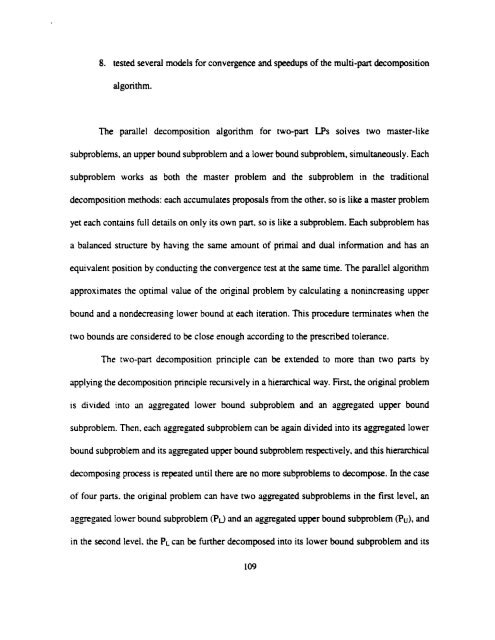X - UWSpace - University of Waterloo
X - UWSpace - University of Waterloo
X - UWSpace - University of Waterloo
You also want an ePaper? Increase the reach of your titles
YUMPU automatically turns print PDFs into web optimized ePapers that Google loves.
8. tested several models for convergence and speedups <strong>of</strong> the multi-part decomposition<br />
aigorithm.<br />
The parallel decomposition aigorithm for two-part LPs solves two master-like<br />
subproblems. an upper bound subproblem and a lower bound subproblem, simultaneously. Each<br />
subproblem works as both the master problem and the subproblem in the naditional<br />
decomposition methods: each ûccurnuiates proposais from the other. so is like a master problem<br />
yet each contains full details on only its own part. so is like a subproblem. Each subproblem has<br />
a balanced structure by having the same amount <strong>of</strong> primai and dual information and has an<br />
equivalent position by conducting the convergence test at the same time. The parailel aiprithm<br />
approximates the optimal value <strong>of</strong> the original problem by calculating a nonincreving upper<br />
bound and a nondecreasing lower bound 3t each iteration. This pracedure terminates when the<br />
two bounds are considered to be close enough according to the prescribed tolerance.<br />
The two-part decomposition principle cm in eetended to more than two parts by<br />
applying the decomposition principle recursively in a hienrchical way. Fint, the original problem<br />
is divided into an aggregated lower bound subproblem and an aggregated upper bound<br />
subproblem. Then. each aggregated subproblem can be again divided into its aggregated lower<br />
bound subproblem and its aggregated upper bound subproblem respectively. and this hieranihical<br />
decomposing process is repeated until there are no more subproblerns to decompose. in the case<br />
<strong>of</strong> four p m. the original prublem cm have two aggregated subpmblems in the fint level. an<br />
aggregated lower bound subproblem (PL) and an aggregated upper bound subproblern (Pu), and<br />
in the second level. the PL cm be fiuther decomposed into its lower bound subproblem and its<br />
IO9
















